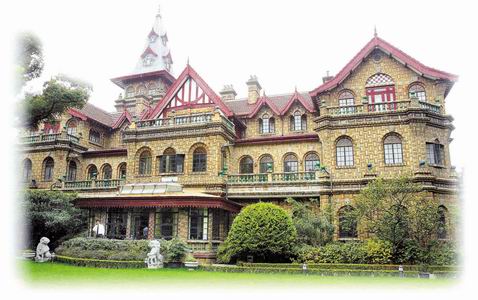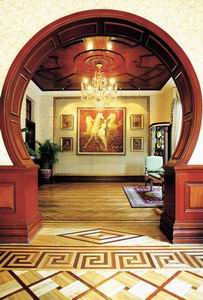Shanghai Daily news

The Moller Villa on Shaanxi Road, one of Shanghai¡¯s
architectural marvels, was built by Swedish shipping tycoon Eric Moller
and completed in 1936.(Photo: Shanghai Daily)

The lobby of
the mansion.(Photo: Shanghai Daily)
On Shaanxi Road, the mansion of a onetime shipping magnate, a fairytale
jumble of spires, steeples and gables floats on a cloud of fables. Tina
Kanagaratnam enters the storybook castle and untangles fact from fantasy.
On
the corner of Shaanxi Road and Yan¡¯an Road, the traffic rushes all around ¡ª
flying above on the elevated highway; zipping past at ground level ¡ª making the
surreal sight of a storybook castle, on that same corner, even more surreal.
With its brooding, Gothic spires that look like witches¡¯ hats, grafted onto
a grand Tudor facade, Moller Villa looks like something from a Hans Christian
Andersen fairytale ¡ª not quite real, and not quite of this world.
Indeed, it
looks like a little girl¡¯s fantasy come to life, so it is no wonder that the
house is popularly supposed to have been conceived in a little girl¡¯s dream.
While Eric Moller, a Swedish shipping tycoon, was planning his family house, his
daughter Deirdre (¡°Dido¡±) Moller is said to have had a dream in which she saw a
fairytale castle. Upon waking, sketched it for her father and Papa Moller was so
fond of this child, the story goes, that he then commissioned an architect to
build her dream house.
Looking at the Gothic fantasy, the tale seems
completely plausible. After all, even in Shanghai, where grand mansions in a
cacophony of international styles are commonplace, Moller villa stands out as
something special, something very different ¡ª something that could certainly
have been inspired by a dream.
But, as it turns out, the story is as
fantastic as the building. Architectural historian Tess Johnston, the author of
¡°A Last Look: Western Architecture in Old Shanghai¡± met Dido in the summer of
1992, and reports that she ¡°stated categorically that there was not a shred of
truth¡± in this story.
Still, something about the mansion seems to inspire
fantasy, for this is not the only fable associated with the villa. Legend has it
that Eric Moller was a Shanghai Horatio Alger ¡ª he is said to have arrived
penniless in Shanghai, and here he made his fortune, culminating in the
construction of his dream house.
In reality, he was the son of wealthy
businessman Nils Moller, who had started a business in Hong Kong in the 1860s.
The business grew and expanded into eight cities in China, and although the
Mollers left Shanghai in 1950, their companies continued operating in Hong Kong
into the 1990s. The core of the family business was shipping and shipbuilding,
and in Shanghai, the Moller portfolio included shipping lines, insurance, real
estate and investment. In 1913, Eric Moller took over the family business, and
prospered. He had a steamboat that ran between Shanghai and Zhenjiang in Jiangsu
Province, and, in the mid-1920s, decided to embark on the construction of a
house for his big family ¡ª six children and a menagerie of dogs and cats.
In
1927, a Shanghainese architectural firm, Allied Architects Hougai, delivered the
blueprint, and the house was essentially finished in 1936. Today, one of the
partners at Allied Architects International (Canada) is Xie Gang, the grandson
of Allied Architects Hougai partner Benjamin Chen. While Xie is not conversant
with the Moller House project, the combination of the distinctly Northern
European style and the architectural references to ships throughout the house
hint that Moller was probably heavily involved in the design.
A pair
of Chinese lions flank the entrance of the house, leading to the ornate
first-floor interior, a landlubber¡¯s version of the grand cruise ships that
defined this era: there are substantial marble pillars, two short ¡°cruise ship¡±
flights of stairs that meet at a central landing flanked with iron banisters,
and everywhere ¡ª the floors, the ceilings, the walls ¡ª is the beautiful Swedish
wood that Moller brought over on his own ships.
After almost half a century
as the headquarters of the Shanghai Communist Youth League Shanghai branch,
Moller¡¯s house is today a boutique hotel, managed by the Hengshan Group. Dining
rooms and a cafe occupy what were once the grand public rooms on the first
floor, but the exquisite workmanship is still apparent.
The wooden columns
next to the staircase are elaborately carved, as are the ceiling beams. The
wooden underside of the stairs shows a stylized compass, and, also by the
stairs, there is a round porthole- shaped window. Even in the kitchens,
the beautiful, colorful tile is still intact.
The house rambles, as a
Gothic mansion should. The rooms that housed the family are on the second floor,
and a back stairway ¡ª the servant¡¯s stairs ¡ª runs up the side of the house, all
the way up to the smaller rooms on the third floor, where presumably the
servants lived. Also on the third floor, an elliptical rail stands in one room
as a reference to a ship¡¯s machine room. In one room, a beautiful domed
skylight, lined with wood and a wreath of leaves, allows light to flood in.
There are tiny rooms, way up under the eaves, and stairs that lead here, there,
and sometimes, it seems, nowhere.
Outside, glazed tiles intersperse the
bricks, giving the otherwise dark house a lift of color. An enclosed porch leads
to a lovely green garden, where a statue of a copper horse stands. Moller, as
with many of Shanghai¡¯s richest men, was an avid racer of horses and a member in
good standing of the exclusive Shanghai Racing Club. The story is that the
copper horse marks the spot where Moller had buried his favorite Arabian
racehorse ¡ª a favorite because of the amounts of money it had won for its owner.
Later, the family¡¯s dogs and cats joined the horse.
It was said that a
fortuneteller told Moller that if he ever finished the house, ill fortune would
befall him. So Moller dawdled, adding bits and bobs (perhaps, one imagines, the
reason that the house rambles) for more than 10 years, finally finishing it all
in the late 1940s. According to Johnston, Dido says that this, too, is false ¡ª
but there is no doubt that Moller¡¯s fortunes took a turn for the worse after
1949.
Moller left Shanghai after the Liberation, and a few years later, in
1954, he flew to Singapore, where, as his daughter Nancy watched and waited for
him at Singapore¡¯s Kallang Airport, his Qantas plane crashed on landing, killing
Eric Moller and 32
other passengers.
According to Johnston, his elder
sons, Eric Jr and Ralph (¡°Budgy¡±) took over their father¡¯s business after he
died. The interest in horses continued in the next generation, and they owned a
successful stud farm, White Lodge Stud, in Newmarket, England.
Moller¡¯s
house may not have been built from his daughter¡¯s dream, but the fanciful castle
in the city remains the encapsulation of a dream ¡ª the dreams of Eric
Moller.



